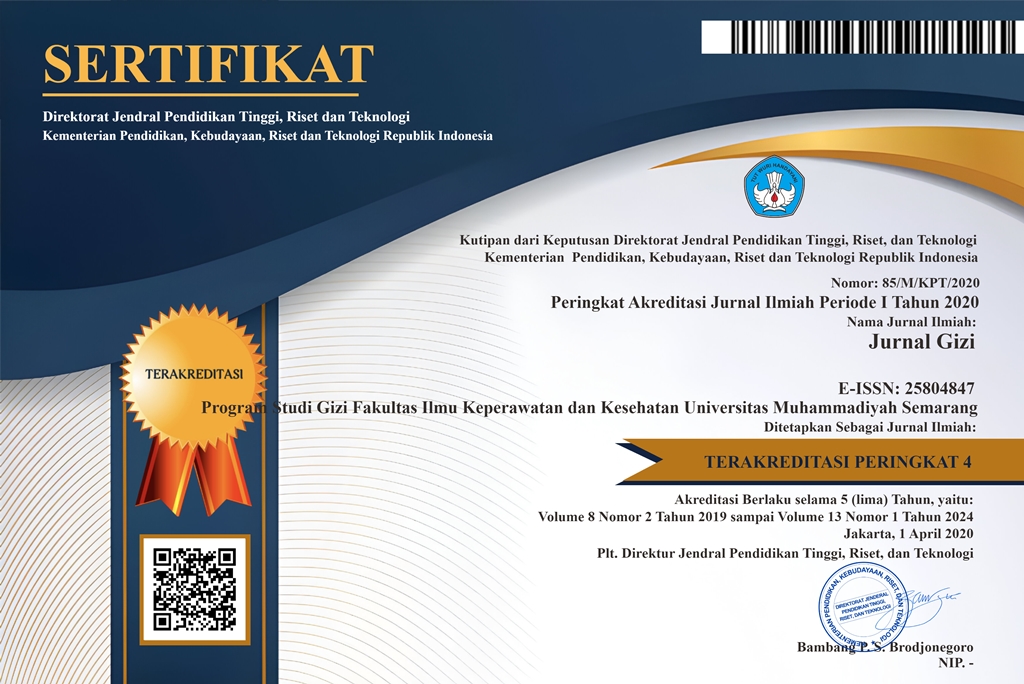Kualitas dan Cara Pengelolaan Garam Iodium Keluarga
(1)
(2)
(3)
(*) Corresponding Author
Abstract
The low consumption of iodized salt can cause a disturbance due to the iodine deficiency (GAKY). People were expected to consumed foods that contain high iodine or consumed iodized salt that qualifies quality to overcome the problem. Selection, storage and using of iodized salt may reduced the effectiveness of the used of iodized salt.
The researcher used expolorative research design with descriptive analysis. The population of the research is the total number of households in the working area of health center of Toroh 1 Grobogan Regency. The number of samples of 100 RT mothers who were adopted by the method of Multi Stage random sampling. Methods of data collection of the
research variables were interviews using questionnaires and observations.
The results showed that 90.9% of the iodized salt in the market fulfilled the quality requirement and 69% iodized salt in the household fulfilled qualified. The choosing of iodized salt by respondents were still experiencing an error based on how to store iodized salt intact
as much as 82%. The salt storage container used a plastic jar container of 52%, the storage location of iodized salt in a humid place of 77% and 81% of salt stored in unexposed source of heat and the processing of the respondents were still experiencing an error (91%) of
respondents including the cooking process.
The management of iodized salt at the household level has not met the standards, especially in the used of iodine salt in food. This research was expected to improve the knowledge management of iodized salt which was correct and standard.
Keywords: iodized salt, quality, family management, iodine level.
The researcher used expolorative research design with descriptive analysis. The population of the research is the total number of households in the working area of health center of Toroh 1 Grobogan Regency. The number of samples of 100 RT mothers who were adopted by the method of Multi Stage random sampling. Methods of data collection of the
research variables were interviews using questionnaires and observations.
The results showed that 90.9% of the iodized salt in the market fulfilled the quality requirement and 69% iodized salt in the household fulfilled qualified. The choosing of iodized salt by respondents were still experiencing an error based on how to store iodized salt intact
as much as 82%. The salt storage container used a plastic jar container of 52%, the storage location of iodized salt in a humid place of 77% and 81% of salt stored in unexposed source of heat and the processing of the respondents were still experiencing an error (91%) of
respondents including the cooking process.
The management of iodized salt at the household level has not met the standards, especially in the used of iodine salt in food. This research was expected to improve the knowledge management of iodized salt which was correct and standard.
Keywords: iodized salt, quality, family management, iodine level.
Full Text:
PDFArticle Metrics
Abstract view : 949 timesPDF - 401 times
DOI: https://doi.org/10.26714/jg.8.1.2019.%25p
Refbacks
- There are currently no refbacks.
Diterbitkan oleh: Program Studi Gizi (D3 dan S1)
Fakultas Ilmu Keperawatan dan Kesehatan
Universitas Muhammadiyah Semarang
Sekretariat: Jl. Kedungmundu Raya No. 18 Semarang
Contact Person : Hapsari Sulistya Kusuma, S.Gz, M.Si (+62 85 6 41 536 553)

This work is licensed under a Creative Commons Attribution 4.0 International License.










.png)
.png)
_.png)